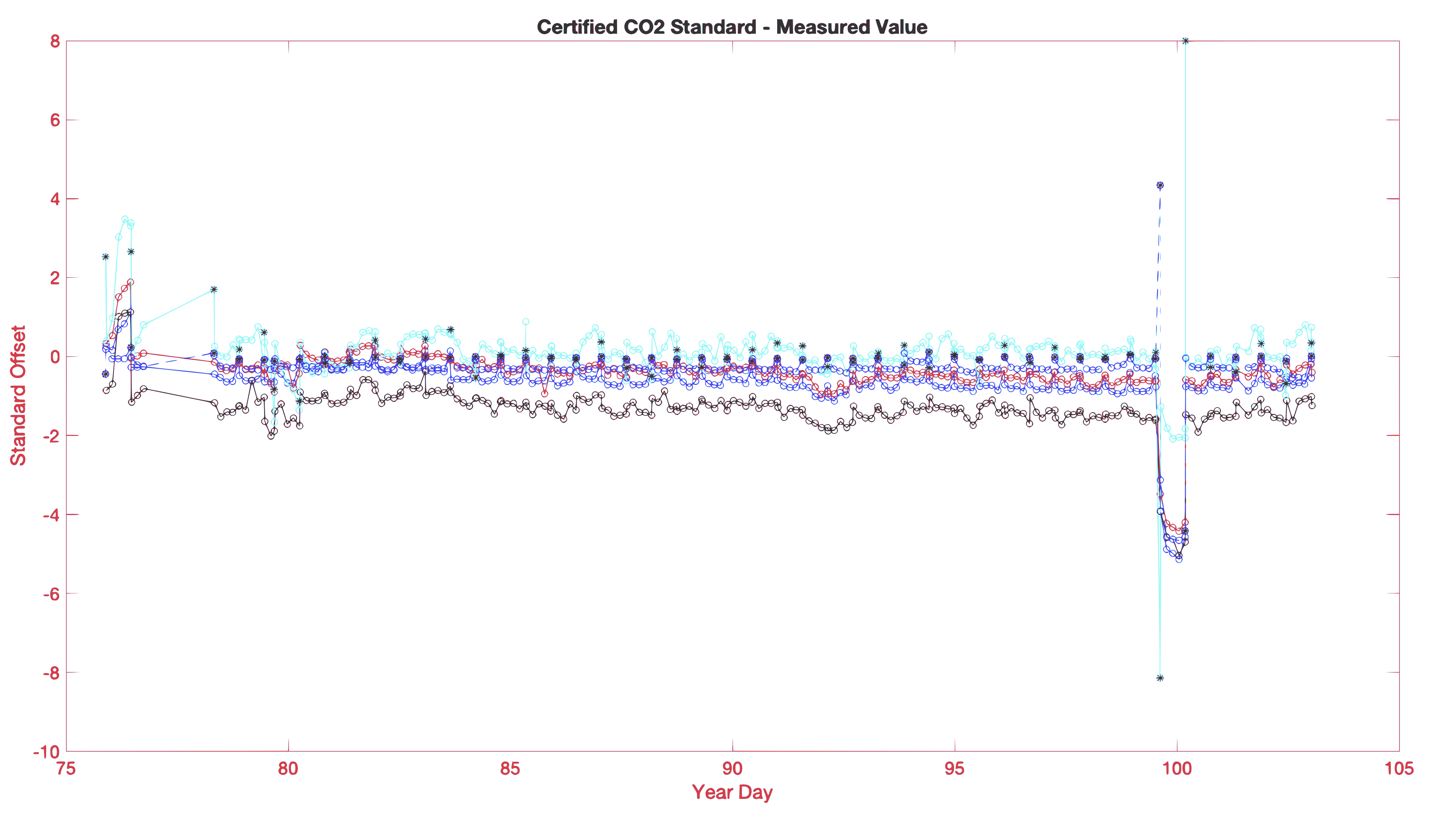Underway pCO2¶
- PIs
Simone Alin (NOAA/PMEL)
- Analysts
Andrew Collins (NOAA/PMEL)
The partial pressure of CO2 (pCO2) in the surface ocean was measured throughout the duration of this expedition with a General Oceanics 8050 underway system.Uncontaminated seawater was continuously passed (~2.8 l/min) through a chamber where the seawater concentration of dissolved CO2 was equilibrated with an overlying headspace gas. The CO2 mole fraction of this headspace gas (xCO2) was measured approximately every three minutes via a non-dispersive infrared analyzer (Licor 7000). Roughly every three hours, the system measured four gas standards with known CO2 concentrations certified by the NOAA Earth Science Research Laboratory in Boulder, CO ranging from ~300 – 900 ppm CO2. Additionally, a tank of 99.9995% ultra-high purity nitrogen gas was measured as a baseline 0% CO2 standard. Following measurements of standard gases, six measurements of atmospheric xCO2 were made of air supplied through tubing fastened to the ships starboard jackstaff. Twice a day, the infrared analyzer was calibrated via a zero and span routine using the nitrogen gas and the highest concentration (872.6 ppm) CO2 standard. In addition to measurements of seawater xCO2, atmospheric xCO2, and standard gases, several variables were monitored to evaluate system performance (e.g. gas and water flow rates, pump speeds, equilibrator pressures, etc). For more detail on the general design of this underway pCO2 system, see [Pierrot2009].
A Seabird (SBE) 38 temperature sensor located at the ship’s seawater intake provided measurements of in situ seawater temperature, while a SBE 45 thermosalinograph monitored temperature and salinity in the bow of the ship before the seawater reached the pCO2 system. An Aanderaa 4330 optode plumbed in line with the pCO2 system water supply measured dissolved oxygen (DO) continuously. Additionally, a modified SeaFET system was also plumbed in line which measured pH throughout the duration of the cruise.
During the transit from Woods Hole to the first hydrographic station, discrete samples (n=37) for measurements of dissolved inorganic carbon, total alkalinity, pH, DO, nutrients (nitrate, nitrate, silica, phosphate), and salinity were drawn from the ships uncontaminated seawater supply every four hours. These were analyzed onboard and will be used for comparison to measurements collected by the underway system.
A preliminary round of processing was performed on this dataset using Matlab routines developed by Denis Pierrot of the Atlantic Oceanic and Meteorological Lab in Miami, FL. In two brief instances, the underway system was shut down for minor maintenance to be performed. During our initial transit to the first CTD station, the system was shut down while passing through the Canadian Exclusive Economic Zone. A ~12-hour data gap occurred (20-March) when the cable sending the ship’s SCS data (position, intake temperature, etc) was loose; this data will be recovered and merged with the dataset during the next round of processing. Of 13,056 measurements, four were assigned a WOCE quality flag of 4 (bad measurement), while none were assigned a quality flag of 3 (questionable measurement) during this initial round of processing. Measurements of gas standards were within 1% of their certified value throughout the duration of the expedition, save for one brief period where the Licor demonstrated some drift (Figure 1).
Preliminary review of collected data suggest that the main control on the surface seawater carbonate system was temperature (Figure 2). Excursions from thermodynamic controls on pCO2, pH and DO were measured during the brief time spent on the continental shelf near the coast of South America, where extremely low values of pCO2 were measured. Concomitant changes were observed in pH, DO, DIC, and other variables. The likely causes of these low values are likely due to dilution of seawater by riverine input (e.g. Amazon; surface salinities dropped below 20 PSU), and potentially by fixation of dissolved carbon via primary production. However, further evaluation of these data and the supplementary suite of discrete measurements that were collected is needed before the controls on pCO2, pH and DO can be fully elucidated.
This dataset should be considered preliminary; additional quality control and quality assurance is needed before these data can be considered final.

Difference between measurements made by the non-dispersive infrared analyzer (Licor 7000) of gas standards and the known certified value of those standards (in ppm CO2).¶

Spatial distribution of the relevant parameters (sea surface temperature [SST, oC], sea surface salinity [PSU], fCO2 [ppm], pH, and DO [M]) measured by the underway pCO2 system during the 2021 GO-SHIP A20 research expedition.¶
- Pierrot2009
Pierrot, D., Neill, C., Sullivan, K., Castle, R., Wanninkof, R.W., Lüger, H., Johannessen, T., Olsen, A., Feely, R.A., Cosca, C.E.; 2009. Recommendations for autonomous underway pCO2 measuring systems and data-reduction routines. Deep-Sea Research II 56 (2009) 512–522